Photos with this report (click to enlarge) | |||
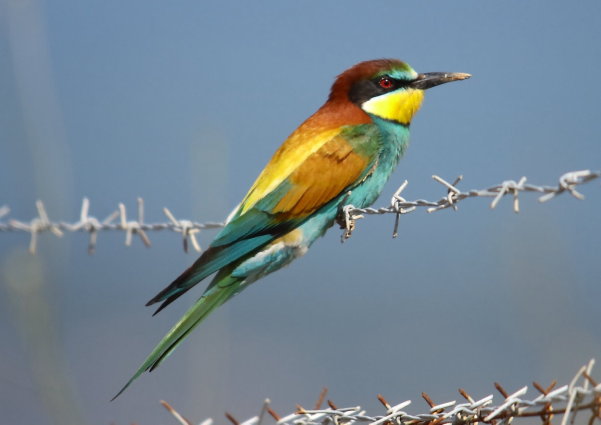 Euoropean bee-eater |
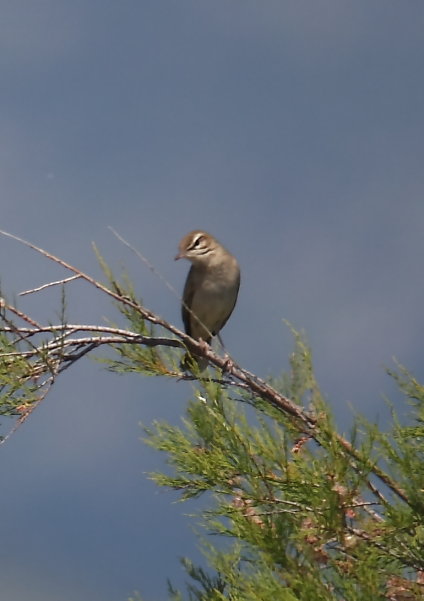 Rufous |
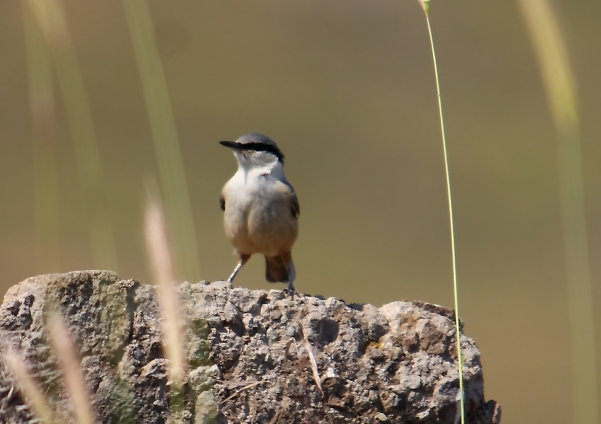 Rock Nuthatch |
|
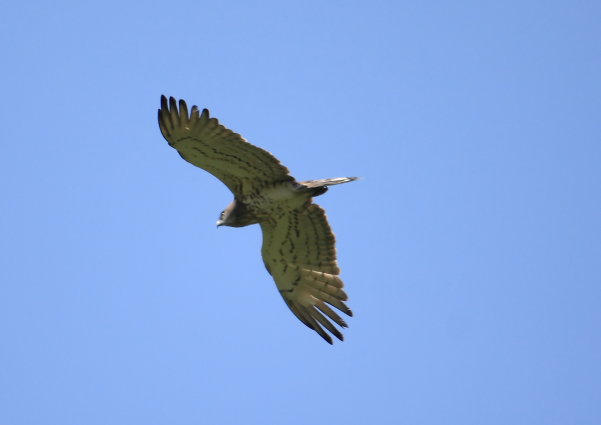 Short Toed Eagle |
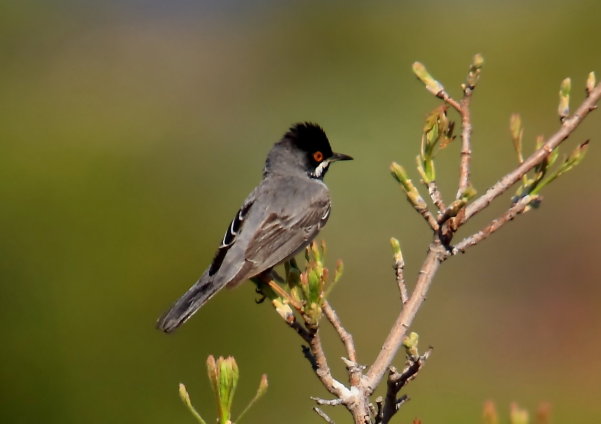 Ruppel's Warbler |
||
KEY SITES VISITED:
Lesvos, Ipsilou, Kaloni East River, Petra, Petri, Skala Kalloni Flooded Fields and Salt Pans, Sigri, Ipsilou.
LESVOS:
A Greek island located in the Eastern Aegean on the migration routes for birds travelling to north-eastern Europe, Turkey and Asia Minor.
Best times for Birding: April to mid June, Sept to October. June - August are the hottest months, with the temps over 40c (having tried July, its both extremely hot and quiet birding wise)
Itinerary:
Flying from Manchester Terminal 2 on Thursday 7 May at 7:30. Arriving Mytilene about 13.30 local time. Returning Thursday 21st May on the same return flight.
Although there was a transfer coach at the airport,we picked up a car from Billy's. We made our way to Anaxos via lunch at Skala Kalloni.
Note: Our holiday was booked as a package on line, via First Choice at a cost of £780 for the two weeks.
Prices are now up on last year, however Lesvos still offers value for money as a beach,birding,sight seeing and hiking holiday, particularly during the cooler months.
We have had 2.5cm of hail at the Petrified Forest on one occasion in early May. The weather at this time can vary, including both wind and rain, however this generally gives way to prolonged sunny spells. However this year we were a week later and the weather was excellent.
Manos offer Saturday flights, however please be aware that due to the limited availability, the first two weeks of May packages, book up with birders pretty early.
The main birding centre is Skala Kaloni, however few UK package operators have properties there. Flights only can be booked. For those wanting an organized tour Steve Dudley has built an excellent reputation, for his Lesvos birding tours and has a guide published this summer, which is an excellent companion to the renown Richard Brooks book.
Steve Dudley's website is packed with useful information on aspects of Lesvos wild life. Go to: http://www.toadsnatcher.com/
THE TRIP:
Anaxos Hotel. Located in the north west of the island, we stayed at the Anaxos Hotel. Both the food and hospitality of the family; Paul, Effy, Frank and Tony, who run the hotel is always of the highest standard.
Weather: The weather (unlike the preceding two weeks which we were led to believe was cool and windy), was for the most part hot, in the high 20’s C and sunny.
During the night of the 18th May we had thunder, lightening and rain in the night, from the 19th to the 21st there were occasional localised light rain showers interrupting the sunshine. On the morning of 19 May, following the thunder storms, the fences and wires at Sigri were dripping with spotted flycatchers and red-backed shrikes.
As returning Lesvos birders will know, birding on the island can be different every season. Whilst last years May visits to the Skala Kalloni Salt Pans were characterised by good views of red-footed falcons, pratincole, red-throated pipits, rose-coloured starlings and spur-winged plover, on the largely dry “sheep fields”, this year following one of the islands wettest winters for some years, the same area this year had now turned into a lively fresh water marsh. It became home to numerous species of heron, ducks, waders and terns. In fact we never saw a red-foot nor rosy, the latter you could almost say would be guaranteed the second week of May – though to our surprise for the first time in years though, they never turned up in any numbers and we dipped!
There are some species however, which are guaranteed and evocative of a spring visit to the island.
It’s hard to imagine travelling the length of the UK to see a crested lark, the object of a major twitch on the south coast in April, when they are so common on Lesvos. Black-headed, corn and cirl bunting are easily seen along with black-eared wheatear, subalpine and olivaceous warbler. Nightingale sing from cover, anywhere near water.
You can also practically run into short-toed eagle and long-legged buzzard anywhere.
Bee-eaters are profligate and many species of waders and herons easily seen at Skala Kalloni.
Logistics:
The roads are generally good, however there are some birding sites where a four wheel would be more practical.
For some reason the authorities on decided to under take work on the roads for the start of the season, including the beach road at Faneromeni, which was getting a newly concreted road.
The scops owl eucalyptus tree site at the Kalloni mini soccer pitch, was the subject of major tree cropping during the second week of May, rendering our decision to leave a visit to a later date fatal, since the birds were no where to be seen when we did decide to call on a Sunday, although no work was being done.
It’s worth noting that those due to fly back on 14 May got a bonus extra day’s birding, on account of the Greek national strike preventing flights in and out of Mitilini airport on the normal Thursday transfer day.
Environment:
On a positive note, the rivers and streams on the island were all running a lot clearer and cleaner than we have previously seen. This was particularly noticeable of the previously “smelly” Voulgaris at Perivoli, which appeared to have been utilised by the town of Andissa as an open sewer. I cannot however confirm whether this is due as we hoped, to the local government cleaning up its act, or the purging effect on the rivers of a very wet winter. On Sunday 17 May however, the only bird on the river was a single ruddy shelduck.
People:
Local people are generally friendly and welcoming, however some farmers can get upset with invading birders.
It was nice to bump into Bob and Sandra Taylor, Jenny and Bob, Frank and Sheila and finally Steve and Diane Gibson, who kept us entertained over the two weeks.
I would like to thank Jenny and Bob for their birding tips, through which we were able to add some species, which we might have otherwise have missed.
SITE REPORTS:
1. Anaxos;
Common at this site were: Woodchat and red-backed shrike. Black-eared wheatear, crested lark, finches, swifts, barn and red-rumped swallow, olivacious warbler, blackbird, blue and great tit. Hooded crow and jackdaw.
Friday 8 May 2009
Arising at 6.00 and taking an early morning walk part way along the coastal path to Ambelia which was largely quiet, highlighted by a lesser grey shrike, 6 sombre tits, subalpine, sedge and orphean warbler. Rock nuthatch, subalpine and orphean warbler were also present. A kestrel flew over the headland.
Tues 12 May
A little bittern was present at the “Anaxos pool” every time we passed over the next week. As we walked into the Petra at dusk, for a meal at the wonderful Ladies Co-operative, a nightjar was hawking over the rocky outcrop near the Alma Hotel.
Wed 13 May
Whilst walking to Petra on the “valley of the mills” walk, a white wagtail was at one of the Petra streams along with some water snakes.
2.Achladeri
Friday 8 May:
The army was at the site, disrupted our plans for an early morning visit. A pair of Krupers nuthatch were feeding young, appearing every half hour or so. A short toed tree creeper climbed a near bye tree, whilst woodchat and masked shrike flitted in the pines.
Nearby at the “Derbyshire” 2 common shelduck were at the beach along with 5 little egret, whilst on the salt marsh there was also a count of 26 ruddy shelduck.
Friday 15 May:
The Krupers were still at the nesting site.
3. Faneromeni Ford & Beach /Sigri
Common at this site: Woodchat and red-backed shrike. Black-eared wheatear, crested lark, finches, swifts, barn and red-rumped swallow, Oivacious, reed, cettis & orphean warbler, bee-eater, turtle dove, little bittern
During our time in Lesvos the Faneromeni Beach road was closed due to workmen laying a concrete road, however I walked down to the beach on the 12 May, nothing much was showing, except:
12 May:
A middle spotted woodpecker was in the olive groves, nearbye we came across what looked like an olive tree warbler feeding young in a nest made up in an olive sapling.
A little ringed plover was at the ford along with 6 little bittern (on the river). Six blue headed (flava) wagtails were near the ford road, in a recently cut meadow. A Ruddy Shelduck was honking away on beach, it turned out that two juveniles were on the estuary, indicating breeding in the area. A party of yelkouan shearwater skimmed the offshore horizon heading west. A purple heron took off from a nearby field planted with "greens" and headed up river. A honey buzzard, short toed eagle x 2, lesser kestrel x 2, long-legged buzzard x 3 flew over.
A roufus bush robin, lighted briefly and was scared off by a woodchat shrike, on the telegraph wires near the dry stream bed bridge.
We also called at the Sigri sanatorium hoping for bush robin, however had to make do with four northern wheatear and a large noisy flock of several hundred spanish sparrow which had taken up residence in a large mulberry tree, prowled by a kestrel.
Sunday 17 May:
Stopping at the dry stream again for a morning brew, two bush robin flitted with a couple of yards from us on the track displaying and gathering nesting materials they hung about for a few minutes before flying off, we never saw them again. A turtle dove was on the track. The olive tree warbler was still at the nest with four young, golden orioles were calling. A party of some 20 rock doves flew over following the river. 2 little bittern were at the ford. A lesser grey shrike was in a tree along with about 30 bee-eaters.
5.Kalloni Inland (Metochia) Lake
Friday 8 May 2009:
A single little bittern, common swifts, sand and house martins were hawking over the “lake�. A moorhen and two little grebes with two young were present. Cetti’s, reed, great reed and olivacious warblers were flitting amongst the reeds.
6.Kremaste (roman) Bridge
The track from the Petra/Kalloni Road, crossing several streams including the ancient Kremaste Bridge and connecting with Agh.Peraskevi, is very drivable and good for viewing raptors over the ridges along with shrikes, hoopoe, turtle doves, sombre tit and warblers (including olive tree) in the olive groves.
14 May :
2 common buzzard, 1 long-legged buzzard, 1 short-toed eagle.
20 May:
3 common buzzard, short-toed eagle, hoopoe x 3, orphean warbler
7. Molivos
Sat 16 May:
Staying local we headed off to Molivos for a quay side lunch of fresh kalamari and a stroll around the cobbled streets. However the sky above the castle was full of the wonderful sight of screaming common and a few alpine swifts. The swifts also swooped down and briefly hung on to the underside of the overlapping tiles.
8.Napi Valley
Common at this site were: Chaffinch, gold and greenfinch. Crested lark. Subalpine and orphean warbler. Woodchat, masked and red-backed shrike. Black-headed, cirl, corn and cretzschmars bunting, black-eared and northern wheatear. Hoopoe and bee-eater.
Monday 11 May:
Limited birding to day, whilst taking a day off driving to Molivos and the north coast. A woodlark was singing from a dead tree.
9.Petra Disco Site
Saturday 16 May:
We stopped briefly for views of orphean and ruppell’s warbler, a cormorant fishing off the cliffs, blue rock thrush, crag martin and the common buntings and wheatear.
10.Parakila Marsh:
In recent years visits have not proven fruitful, this occasion was no exception.
Monday 18 May:
One squacco heron and a black-winged stilt.
11.Petri and the valley of the Mills.
Note: We visited this site three times over the two weeks seeing the species listed. Anyone visiting Petri for either a short walk or to hike one of the many trails up there, will usually stop at the Petri Taverna, for either the best of authentic Greek cooking or to take in the fantastic views of the Petra coastal plain and Church, with a frappe or Alpha. Maria who manages the taverna told me that her father, who used help out, unfortunately passed away, suddenly three months earlier.
The Valley of the Mills is possibly the most accessible spot in north Lesvos for reasonable views of Raven, two pairs of which inhabited the unusual rock formations. Also seen there were; rock nuthatch, black-eared wheatear and blue rock thrush.
In early May good views of shrike (including Masked) are guaranteed, from the track which cuts through the woodland. Other common woodland birds included: turtle dove, tits, ms wood, greenfinch, chaffinch, goldfinch, hoopoe, buntings, nightingale and warblers. Bee-eaters burrow in the sandy banks of the disused quarries whilst raptors, martins, swifts and swallows scud under the high ridges (of Mt Rousa 582m) and above the radio masts.
20 May:
We had a sparrowhawk, 3 common buzzard, 1 long-legged buzzard mobbed by hooded crows, 1 short-toed eagle. In other years we have also had golden oriole here.
12.Potamia Valley/Potamia old reservoir:
Thurs 14 May:
Common woodland birds, buntings and shrikes. 2 common buzzard, crag martins, middle spotted woodpecker
Mon 18 May: Potamia old reservoir:
This location has previously escaped our attention; however we were put onto it by Bob and Jenny from Yorkshire. Unfortunately it looks as though it is gradually being filled in. At the site were: 3x night heron, a squacco, coot and little grebe.
13.Skala Kalloni Salt Pans, East River and Flooded Sheep Fields
Common at the above sites were: Corn and black-headed bunting, crested lark, house and spanish sparrow. European bee-eater, yellow and black-headed wagtails. Greenfinch, chaffinch, goldfinch. Black-winged stilt, avocet, greater flamingo, ruff, wood sandpiper, little stint, curlew sandpiper, ringed, little ringed and Kentish plover. Avocet, grey heron, black and white stork. Common, little and whiskered terns. Yellow-legged gull and hooded crow.
It’s also always worth checking out the “salt tank” walls for stone curlew.
13.01.Skala Kalloni Beach Café:
Friday 8 May 2009:
A tawny pipit was on the beach. 2 cormorants were on the old jetty. Also in the same area were 6 short-toed larks, 1 stone curlew and a single bush robin.
13.02.Skala Kalloni East River/Ford:
Common at this site were: Reed, olivacious and cetti’s warblers.
Thursday 14 May:
As we crossed the ford a Citrine Wagtail made its way upstream.
Friday 15 May:
Two ringed plover were displaying at the ford. On the track from the Ford to the Salt Pans two whitethroat were singing from the wires, about 15
Bee-eaters were hawking from the barbed wire fences.
Monday 18 May:
A cormorant and ringed plover were on the east river along with a singing great reed warbler. Over the fields to the west of the farm track, there was a light phase common buzzard and a large unidentified raptor, brown with wide wings and with white upper wing spots and a light tail patch.
Wednesday 20 May:
At the sand spits on the East River mouth, amongst the common and little terns were four sandwich terns
(a Caspian tern had been reported there the previous day but we dipped), a little ringed plover and a lovely summer plumage turnstone.
13.03.Skala Kalloni flooded sheep fields:
Great white egret, black and white stork, glossy ibis, squacco and grey heron, a male garganey and up to 4 mallard were present here through out the two weeks. Common, little, whiskered and white winged black terns were present throughout.
10 May:
10 Collared pratincole, hawked overhead.
Thurs 14 May:
A spur-winged plover had arrived overnight whilst a single collared pratincole was on a strip of land.
Two female marsh harriers skimmed the freshwater marsh and then headed east over the salt pans. Two grey plover were on the salt tanks visible from the main road hide. 3x great white egret, 8 x squacco heron, 8 little egrets, 2 x glossy ibis, were present.
Friday 15 May:
6 collared pranticole dropped in and the spur winged plover was still there.
Monday 18 May:
Glossy ibis x 10, grey heron x 10, black stork x 8, white stork x 3, squacco x 3. Scoping from the hide we had greenshank, spotted and redshank.
A mystery gull had been prompting debate over the past few days, which we put down as a black-headed gull on account of the prominent eye spot. The spur winged plover was still present. 2 x black terns had joined the terns.
20 May:
8 x glossy ibis, mystery gull still present, black tern, and 2 x gull billed terns. 10 spoonbill had been present in the morning and relocated to the avocet roost on the salt pans.
21 May:
A final visit, hoping but failing to get the rosy starlings, 2 x glossy ibis, 1 x great white egret, black terns and w.w.black terns still present.
13.04.Skala Kalloni Salt Pans
08 May:
In addition to the common waders a Marsh Sandpiper and a Temminck’s stint were present in the channels.
Thurs 14 May:
Two fledgling black-winged stilts were making tentative steps on the side of the channel shore line near the main road.
20 May:
4 common buzzard were soaring over the fields adjacent the salt pans.
A ringtail harrier (possibly pallid) was hawking over the meadows on the land ward side of the main salt pans track, before the small bridge across the channel. Unfortunately it was going away from us as we spotted it. 7 x spoonbill were wading with the avocet roost. As we stopped to scope the spoonbills, a peregrine put up the avocet and stilts mobbing it until it gained height heading into the clouds, suddenly it went into a deadly angled stoop aiming for a stilt which it caught briefly before it somersaulted safely back into the water. The peregrine recuperated on one of the salt tank banks, as we left.
21 May:
30 curlew sandpipers, 4 kentish plover, large number of little stints, 5 wood sandpipers present in the channel. 7 spoonbill on the salt pans.
13.05.Skala Kalloni Sheep fields (south of salt works)
Thurs 14 May:
The sheep field pools still held water and secretive parties of waders including kentish plover, ruff, wood sandpiper, little and temminck’s stint. Black-headed wagtails and whinchats were on the wire fences.
Short-toed, crested larks and bee-eaters were also present.
For further Lesvos 2010 updates and Links to other reports go to :
http://www.birdforum.net/showthread.php?t=170976
For the dedicated Lesvos photo site and to add your own Lesvos birding pictures please got to :
http://www.flickr.com/groups/lesvos_birding/pool/
Ruddy Shelduck
Shelduck
Mallard
Garganey
Little Grebe
Mediterranean Shearwater
Cormorant
Shag
Little Bittern
Night Heron
Squacco Heron
Little Egret
Great White Egret
Grey Heron
Purple Heron
Black Stork
White Stork
Glossy Ibis
Spoonbill
Greater Flamingo
Long-legged Buzzard
Short-toed Eagle
Marsh Harrier
Pallid Harrier
Sparrowhawk
Buzzard
Honey Buzzard
Lesser Kestrel
Kestrel
Eleonora’s Falcon
Peregrine
Moorhen
Coot
Chukar
Black-winged Stilt
Avocet
Stone Curlew
Collared Pratincole
Ringed Plover
Spur-winged Plover
Little Ringed Plover
Kentish Plover
Grey Plover
Turnstone
Little Stint
Temminck’s Stint
Curlew Sandpiper
Ruff
Redshank
Spotted Redshank
Greenshank
Wood Sandpiper
Yellow-legged Gull
Black-headed Gull
Little Tern
Gull-billed Tern
Whiskered Tern
Black Tern
White-winged Black Tern
Common Tern
Rock Dove/Feral Pigeon
Collared Dove
Turtle Dove
Nightjar
Little Owl
Swift
Alpine Swift
Pallid Swift
Bee-eater
Middle Spotted Woodpecker
Hoopoe
Short-toed Lark
Crested Lark
Woodlark
Sand Martin
Crag Martin
Swallow
House Martin
Red-rumped Swallow
Tawny Pipit
Yellow Wagtail
Citrine Wagtail
Pied Wagtail
Rufous Bush Chat
Nightingale
Whinchat
Stonechat
Isabelline Wheatear
Black-eared Wheatear
Northern wheatear
Blue Rock Thrush
Blackbird
Cetti’s Warbler
Sedge Warbler
Reed Warbler
Great Reed Warbler
Eastern Olivaceous Warbler
Olive-tree Warbler
Icterine Warbler
Blackcap
Orphean Warbler
Lesser Whitethroat
Whitethroat
Rüppell’s Warbler
Subalpine Warbler
Wood Warbler
Chiffchaff
Willow Warbler
Spotted Flycatcher
Pied Flycatcher
Blue Tit
Sombre Tit
Great Tit
Kruper´s Nuthatch
Rock Nuthatch
Short-toed treecreeper
Golden Oriole
Red-backed Shrike
Lesser Grey Shrike
Woodchat Shrike
Masked Shrike
Jay
Jackdaw
Hooded Crow
Raven
House Sparrow
Spanish Sparrow
Rock Sparrow
Chaffinch
Greenfinch
Goldfinch
Linnet
Cirl Bunting
Cretzschmar’s Bunting
Cinereous Bunting
Black-headed Bunting
Corn Bunting
137 Species